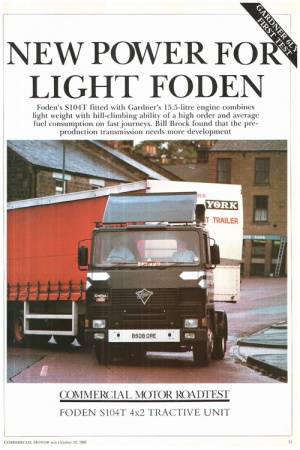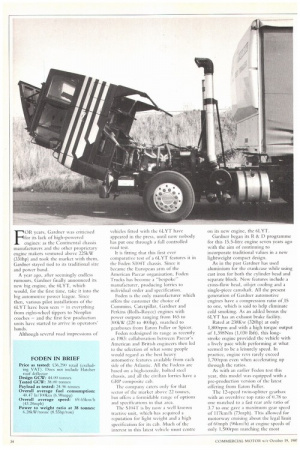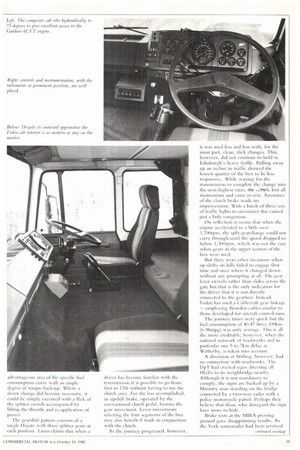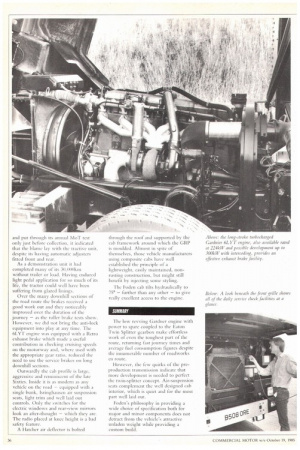NEW POWER FOR LIGHT FODEN
Page 35

Page 36

Page 37

Page 38

If you've noticed an error in this article please click here to report it so we can fix it.
Foden's S104T fitted with Gardner's 15.5-litre engine combines light weight with hill-climbing ability of a high order and average fuel consumption on fast journeys. Bill Brock found that the preproduction transmission needs more development FOR years, Gardner was criticised for its lack of high-powered engines: as the Continental chassis manufacturers and the other proprietary engine makers ventured above 225kW (330hp) and took the market with them, Gardner stayed tied to its traditional size and power band.
A year ago, after seemingly endless rumours, Gardner finally announced its new big engine, the 6LYT, which would, for the first time, take it into the big automotive power league. Since then, various pilot installations of the 6LYT have been seen — in everything from eight-wheel tippers to Neoplan coaches — and the first few production Units have started to arrive in operators' hands.
Although several road impressions of vehicles fitted with the 6LYT have appeared in the press, until now nobody has put one through a full controlled road test.
Jr is fitting that this first ever comparative test of a 6LYT features it in the Foden S104T chassis. Since it became the European arm of the American Paccar organisation, Foden Trucks has become a "bespokemanufacturer, producing lorries to individual order and specification.
Foden is the only manufacturer which offers the customer the choice of Cummins, Caterpillar, Gardner and Perkins (Rolls-Royce) engines with power outputs ranging from 165 to 300kW (22(1 to 400hp), matched to gearboxes from Eaton Fuller or Spicer.
Foden redesigned its range as recently as 1983: collaboration between Paccar's American and British engineers then led to the selection of what some people would regard as the best heavy automotive features available from each side of the Atlantic. All the Fodens are based on a high-tensile, bolted steel chassis, and. all the civilian lorries have a GRP composite cab.
The company caters only for that sector of the market above 22 tonnes, hut offers a formidable range of Options and specifications in that area.
The S104T is by now a well known tractive unit, which has acquired a reputation tbr light weight and a high specification for its cab. Much of the interest in this latest vehicle must centre on its new engine, the 6LYT.
Gardner began its R & D programme for this 15.5-litre engine seven years ago with the aim of continuing to incorporate traditional values in a new lightweight compact design.
As in the past Gardner has used aluminium for the crankcase while using cast iron for both the cylinder head and separate block. New features include a cross-flow head, oil-jet cooling and a single-piece camshaft. All the present generation of Gardner automotive engines have a compression ratio of.15 to one, which is said to help eliminate cold smoking. As an added bonus the 6LYT has an exhaust brake facility.
Rated at 238Kw (320hp) at only 1,800rpm and with a high torque output of 1,398Nm (1,030 lbft), this longstroke engine provided the vehicle with a lively pace while performing at what seemed to be a leisurely speed. In practice, engine revs rarely exceed 1,7(X)rpm even when accelerating up through the ratios.
As with an earlier Foden test this year, this model was equipped with a pre-production version of the latest offering from Eaton Fuller.
The 12-speed twin-splitter gearbox with an overdrive top ratio of 0.78 to one matched to a fast rear axle ratio of 3.7 to one gave a maximum gear speed of 117km/h (73mph). This allowed for motorway cruising about the legal limit of 60mph (96km/h) at engine speeds of only 1,500rpru matching the most
advantageous area of the specific fuel consumption curve with an ample degree of torque back-up. Where a down change did become necessary, it could be simply executed with a flick of the splitter switch accompanied by lifting the throttle and re-application of power.
The gearshift pattern consists of a single H-gate with three splitter gears in each position. Eaton claims that when a driver has become familiar with the transmission it is possible to go from first to 12th without having to USC the clutch once. For the less accomplished, an upshilt brake, operated by the conventional clutch pedal, hastens the gear movement. Lever movements selecting the four segments of the box may also benefit if made in conjunction with the clutch.
As the journey progressed. however,
It was 1.1Sed less and less with. for the most part, clean, slick changes. "[his, however, did not continue to hold in Edinburgh's heavy traffic. Pulling away up an incline in traffic showed the lowest quarter of the box to be less responsive. While waiting for the transmission to complete the change into
the next highest ratio, the yebitle lost all ITIOITICERLIIII and came to rest. Assistance of the clutch brake made no improvement. With a hatch of three sets of traffic lights to encounter this caused just a little congestion.
On reflection it seems that when the engine accelerated to a little over 1,700rpm, the split gearchange could not carry through until the speed dropped to below 1,30Orpm, which was not the case when gears in the upper section of the box were used.
But there were other occasions when up-shifts on hills failed to engage first time and once where it changed down without any prompting at all. The gear lever swivels rather than slides 3crt),is the gate but that is the only indication tOr the driver that it is not directly connected to the gearbox. Instead, Foden has used a Cablecraft gear linkage — employing Bowden cables similar to those developed for aircraft control runs.
The journey times were quick kit the fuel consumption of 40.47 litres 100km (6.98inpg) was only average. .1.1ns is all the more creditable, however, when the national network of roadworks and in particular one 5 to 7kin delay at Wetherby, is taken into account.
A diversion at Stirling, however, had no connection with roadworks. 'Hie DpT had erected signs directing all HGVs to its weighbridge nearby. Although it is not mandatory to comply, the signs are backed up by a Ministry man standing on the bridge connected by a two-way radio with a police motorcycle patrol. Perhaps they believe that those who disregard the sign have more to hide. .
Brake tests at the MIRA proving ground gave disappointing results. As the York semi-trailer had been serviced and put through its ;innual MoT test only just before collection, it indicated that the blame lay with the tractive unit, despite its having automatic adjusters fitted front and rear.
As a demonstration unit it had completed many of its 30,0(J1)kin without trailer or load. Having endured light pedal application for so much of its life, the tractor could well have been suffering from glazed linings.
Over the many downhill sections of the road route the brakes received a good work out and they noticeably improved over the duration of the journey — as the roller brake tests show. However, we did not bring the anti-lock equipment into play at any time. The 6LYT engine was equipped with a Retro exhaust brake which made a useful contribution in checking cruising speeds on the motorway and, where used with the appropriate gear ratio, reduced the need to use the service brakes on long downhill sections.
Outwardly the cab profile is large, aggressive and reminiscent of the late Sixties, inside it is as modern as any vehicle on the road — equipped with a single bunk, Isringhausen air suspension seats, light trim and well laid out controls. Only the switches for the electric windows and rear-view mirrors look an after-thought — which they are. The radio placed at knee height is a bad safety feature.
A Hatcher air deflector is bolted through the ro(■1 and supported by the cab framework around which the GRP is moulded. Almost in spite of themselves, those vehicle manufacturers using composite cabs have well established the principle of a lightweight, easily maintained, nonrusting construction, but might still benefit by injecting some styling.
The Foden cab tilts hydraulically to 75° — further than any other — to give really excellent access to the engine.
SUMMARY
'Hie low rcvving Gardner engine with power to spare coupled to the Eaton Twin Splitter gearbox make effortless work of even the toughest part of the route, returning fast journey times and average fuel consumption figures despite die innumerable number of roadworks en route.
However, the few quirks of the preproduction transmission indicate that more development is needed to perfect the twin-splitter concept. Air-suspension seats complement the well designed cab interior, which is quiet and for the most part well laid out.
Foden's philosophy in providing a wide choice of' specification both for major and minor components does not detract from the vehicle's attractive unladen weight while providing a custom build.




































































































